Cold temperatures harm pets, mirroring the risks their human companions face. A good rule of thumb is that if it’s too cold for you to be outside, it’s probably too cold for your pet. As temperatures across the nation drop, it’s crucial to remember to provide extra protection for your pets in cold weather.
Similar to humans, pets can face weather-related health risks, leading to various potential dangers. Pets left on their own in extremely cold environments are more susceptible to injury and death. Therefore, these few tips will ensure your furry companions stay safe in icy environments.
Like humans, winter can be harsh on our furry little friends. Hence, it’s advisable to shelter them by keeping them inside to prevent disorientation, loss, theft, injury, or harm. Never leave your pets, especially cats, outside.
However, if your pet must stay outside, provide a dry, draft-free shelter. It should be large enough for them to move comfortably but small enough to retain body heat. Furthermore, raise the floor a few inches from the ground, cover it with cedar shavings or straw, and use heavy plastic to cover the doorway.
ALSO READ: Thrift Shopper Buys $2 Gold Trinket, Realizes It Was Made By a Renowned Artist
In addition, safeguard their paws, coat, and skin by wiping their paws with a damp towel after outdoor walks. While on a walk, your pets may step in ice, salt, and chemicals, which can be painful. So, don’t forget to check for cracks in paw pads or redness between the toes. Also, keep these walks brief to minimize cold exposure.
Always maintain home humidity to care for their coat and skin. Upon entering after walks, towel-dry your pet and limit baths. Bathing too often can increase the chance of developing dry, itchy and flaky skin. However, if you must bathe your furry friend, use a moisturizing shampoo.
In addition, never shave your pet down to their skin during winter. If your pet is long-haired, trim them to minimize ice balls and salt crystals that can dry out their skin. As a result of varying body fat and coat type, pets have different tolerance levels and limits.
Hence, you must know your pet’s tolerance levels and limits in cold weather and adjust as needed. Hypothermia and frostbite may be challenging to detect, but if your pet displays signs such as whining, shivering, anxiety, slowness, weakness, or seeking warmth, bring them inside promptly. If you suspect hypothermia or frostbite, consult your veterinarian immediately.
ALSO READ: Does AI Contribute to the World’s Stereotypes and Bias?
Also, always clean up any antifreeze spills. Antifreeze is lethal to pets, and pet parents should be extra careful when using it. Hence, it is advisable to use products that contain propylene glycol rather than ethylene glycol. Furthermore, cold weather chemicals like ice melts can be dangerous when ingested, so be mindful.
Prepare for winter emergencies, like blizzards and power outages. Assemble an emergency kit for your pets with ample food, water, and medicine. Keep the emergency kit on hand. Lastly, make sure you feed your pets well. Dogs and cats, like humans, rely on calories for energy, as it aids them in staying active and warm.
Depending on your pet’s weight and coat type, the number of calories they need varies. Pets with higher fat density and a thick coat may need fewer calories since they are better protected from the cold. Make sure they also drink plenty of water, it will help keep them, and their skin, hydrated.
You Might Also Like:
Pritzker Urges Abbott to Stop Sending Migrants to Chicago, Claims They Are Facing Dangerous Cold
Fetterman Claims Illegal Migrants Swarming the Southern Border Threaten the American Dream
Audio Files Show That the Marine Corps Called 911 To Report Missing F-35 Jet
Florida Rep Accuses Biden Administration of Lying About Texas Migrants’ Drowning
